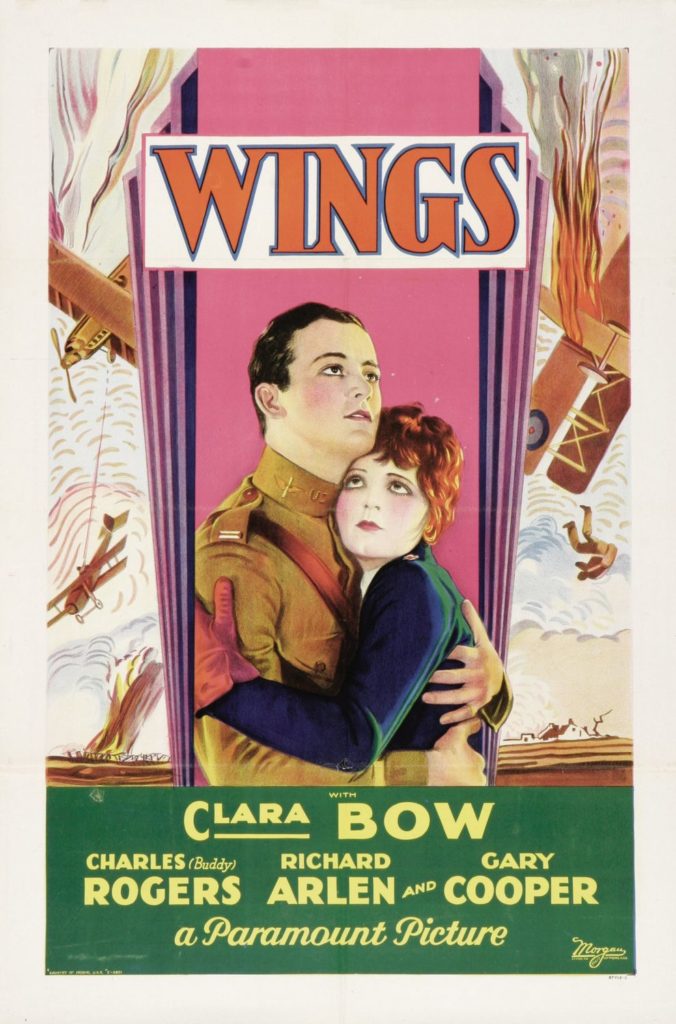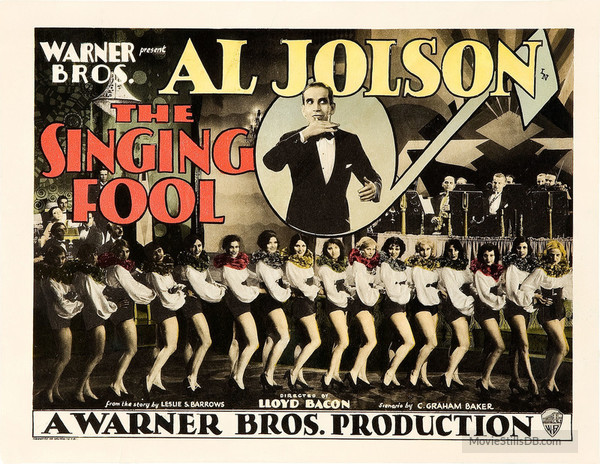1928
Back to the beginning! 1928, the very first Oscars ceremony! Film had finally been around long enough that an institution had formed to hand their colleagues a bunch of golden attaboys.
This was still a time when the things we take for granted in modern film were unthinkable spectacles. The portal scene from Avengers: Endgame had nothing on Al Jolson saying “You ain’t heard nothing yet” right on screen. And I think we see some of that thirst for spectacle in our opening duo of films.
On that note, time for some air combat.
And The Oscar Goes To…
Wings, everybody, the OG BP. What we have here is some pretty standard men-at-war love triangle stuff, only the main female character isn’t in the triangle? That’s different.
Anyhoo, Jack (Charles “Buddy” Rogers) is a middle-class lad who likes building cars and not noticing that the girl next door, Mary (American cinema’s original sex symbol/”it girl” Clara Bow) is crazy about him. No, he likes the hot girl from the city, Sylvia, who herself is in love with David (Richard Arlen), the richest boy in town. Both Jack and David enlist in the air force to go fight in World War One.
Jack and David bond, dogfight some Germans, there’s also a gung-ho recruit whose German name draws suspicion but after a few slapstick scenes he mostly vanishes, and Gary Cooper is a fellow cadet who says he doesn’t see the point in lucky charms because when your number’s up it’s up, then promptly dies within minutes. They weren’t even in combat yet.
Also Mary ships out with the motor corps, and tries to reconnect with Jack while he’s on leave in Paris. Specifically, she tries to tell him that leave is cancelled for the Big Push, but he is staggeringly drunk, minutes from, I assume, getting rolled by a prostitute, so while she saves him from that by luring him away in a borrowed party dress, she gets caught trying to change back into uniform and gets kicked out of the army for loose morals.
Fuck you, patriarchy, Mary was a living saint.
So, obviously, for 1927/28, the flight sequences were impressive. Even if the flames are, by modern standards, clearly drawn on in post. But it’s impressively well shot in a lot of ways. Sylvia and David enjoy a backyard swing together, and the camera is fixed on them, until from out of the swinging background Jack literally sticks himself between them. Later, a camera speed-zooms through a massive swinging party in a Paris club, over tables and between couples until it finds Jack getting life-ruiningly blitzed on champagne. Sure the captions that describe the action (this being a silent movie) get a little purple in their prose, but this is a fairly solid story with some solid twists and pathos. Clara Bow is an utter delight, it’s well directed, the climax held my interest like a vice grip, I like this one.
I do take umbrage with the idea that there was a Big Final Fight That Ended World War One. I’m pretty sure that’s not true. I’m pretty sure they just hit a point where Germany said “Fine, enough, you win,” and people just kept fighting until the Armistice deadline. But there was a lot of “Yay to the troops” energy on this thing, and that calls for a Big Win, something history’s most pointlessly destructive war couldn’t deliver without a little fabrication.
For my full initial reactions, follow the below thread.
And Rotten Tomatoes says: Based on a metric I don’t fully get, of all Best Picture winners, Rotten Tomatoes ranks Wings 57th, with an adjusted score of 96.714%. There’s something else at play in their rankings because it’s definitely not a linear progression of adjusted scores but anyway Wings clocks in at 57/93, finding that the air battle spectacles are less thrilling to modern audiences but Clara Bow mostly makes up for them. So… bottom half, but could be a lot worse.
But what ruled the box office?
The Box Office Champ
Not just the biggest hit of 1928, Al Jolson’s follow-up to The Jazz Singer was the biggest hit Warner Bros. had ever had. Which… well, it’s a less impressive factoid in context, given that Warner Bros. had only existed for five years at that point. But it would hold the record until 1941.
Al Jolson plays a singing waiter at a speakeasy who falls in love with a hateful woman, has a son, loses the woman and his kid, becomes a Broadway star, but his son falls tragically ill. Some pretty standard “rags to riches but at what cost” stuff.
Okay, so, we’re on page one of this project, and we’ve already found one I’m not watching. But while The Jazz Singer earns a place in film history for being the first Talkie, The Singing Fool, while making over one and a half times the money, lacks that historical flair that helps film historians look past Jolson’s continued use of blackface.
Like I said, some of these movies aged worse than Gone With The Wind.
Also, the keynote song, Sonny Boy, was a mammoth hit, the first song from a movie to sell over a million copies. Now, I personally disdain selling a movie on its soundtrack, ever since I heard a radio ad for Pretty Woman that talked about all the songs that were on the soundtrack and didn’t say one word about the actual movie. Nor do I really care that an Offspring song plays in the background of a scene from Batman Forever, or that U2 plays under the credits, those aren’t compelling reasons to see a movie. But when we’re talking proper musicals, the songs are a huge selling point. People see South Pacific to hear “Some Enchanted Evening.” Bollywood movies use their songs to drive ticket sales. And so yes, while I can’t claim expertise here, having a big hit like “Sonny Boy” in the movie was likely a draw in 1928. Throw in the fact that Talkies were the hot new thing in film spectacle, and you have a recipe for big crowds.
While the movie isn’t found on streaming services, and I’m not willing to scour the Dark Web for a copy, “Sonny Boy” is on YouTube. I’m not embedding it here because he sings it in blackface and I don’t want that on my blog.
It’s… okay. Maybe the movie was okay too, who among us knows.
And Rotten Tomatoes says: Yeah, they’ve only barely heard of this one too. So, no ranking. A 60% audience score but lord knows where that’s coming from. The Singing Fool feels like it’s one retirement home COVID outbreak away from exiting living memory, if it hasn’t already.
Other Events in Film
- In a piece of foreshadowing any screenwriter would kill to include, 1928 saw the release of Steamboat Willie. We’re on page one of this journey and Mickey Mouse has already slouched towards Bethlehem to be born.
- Of all the films of 1928, the one my film class specifically studied was The Passion of Joan of Arc, which we examined for its use of extreme close-ups. It is a pure silent movie, so wow is it a struggle to get through without accompanying music.
- Lights of New York was the first “100% Talkie.” Before that, “Talkies” had some spoken elements mixed into a synchronized soundtrack. Even The Singing Fool was a hybrid of spoken and silent elements.
- The MGM lion roared for the first time in 1928. So between the lion, “Oh me oh my” from Mickey Mouse, and Lights of New York, the Oscars debuted as the silent era began to wind to a close.
Next page: All Hail The Biggest Disappointment



One thought on “Art Vs Commerce: Beginnings (20s/30s)”